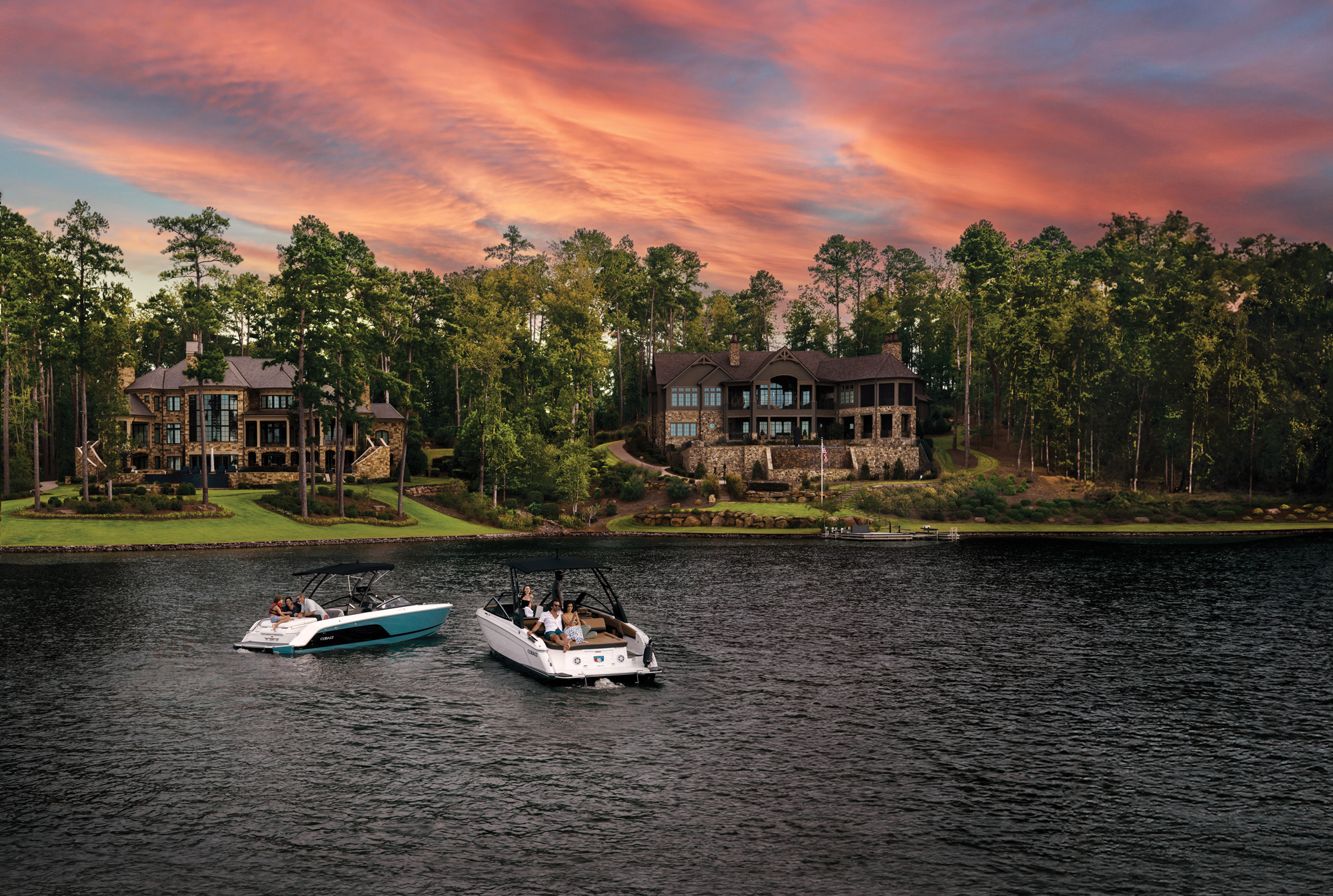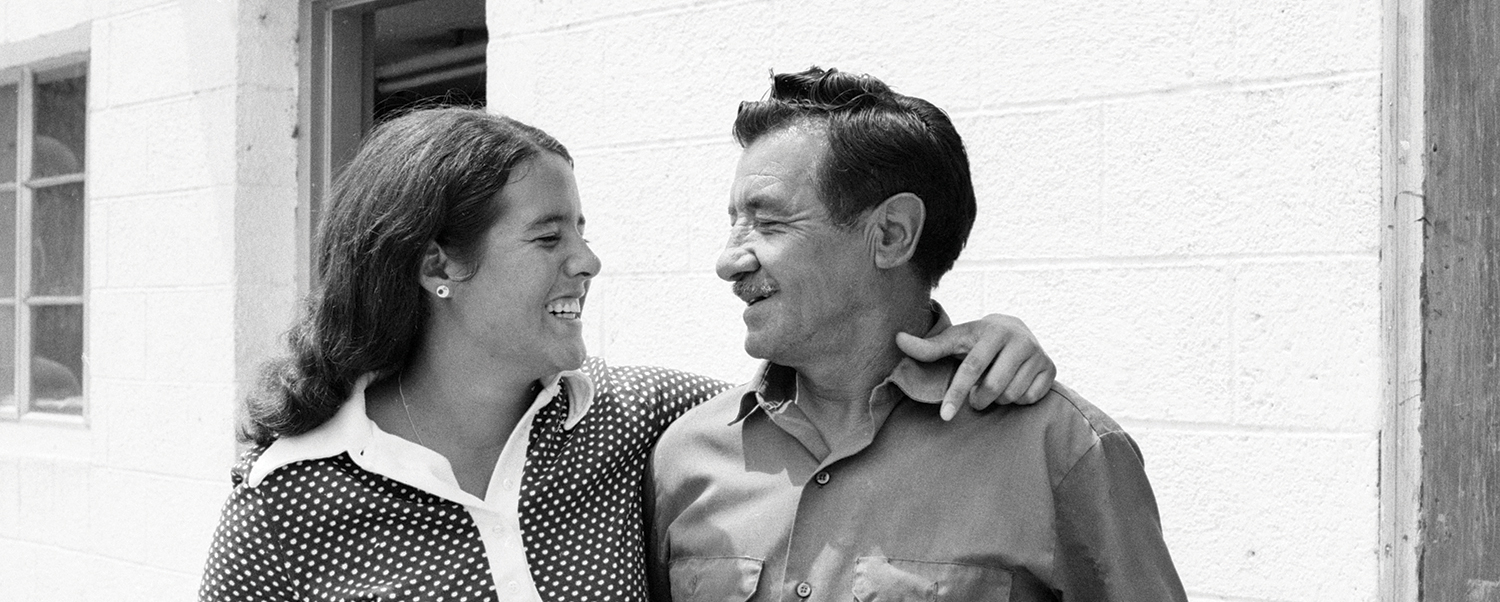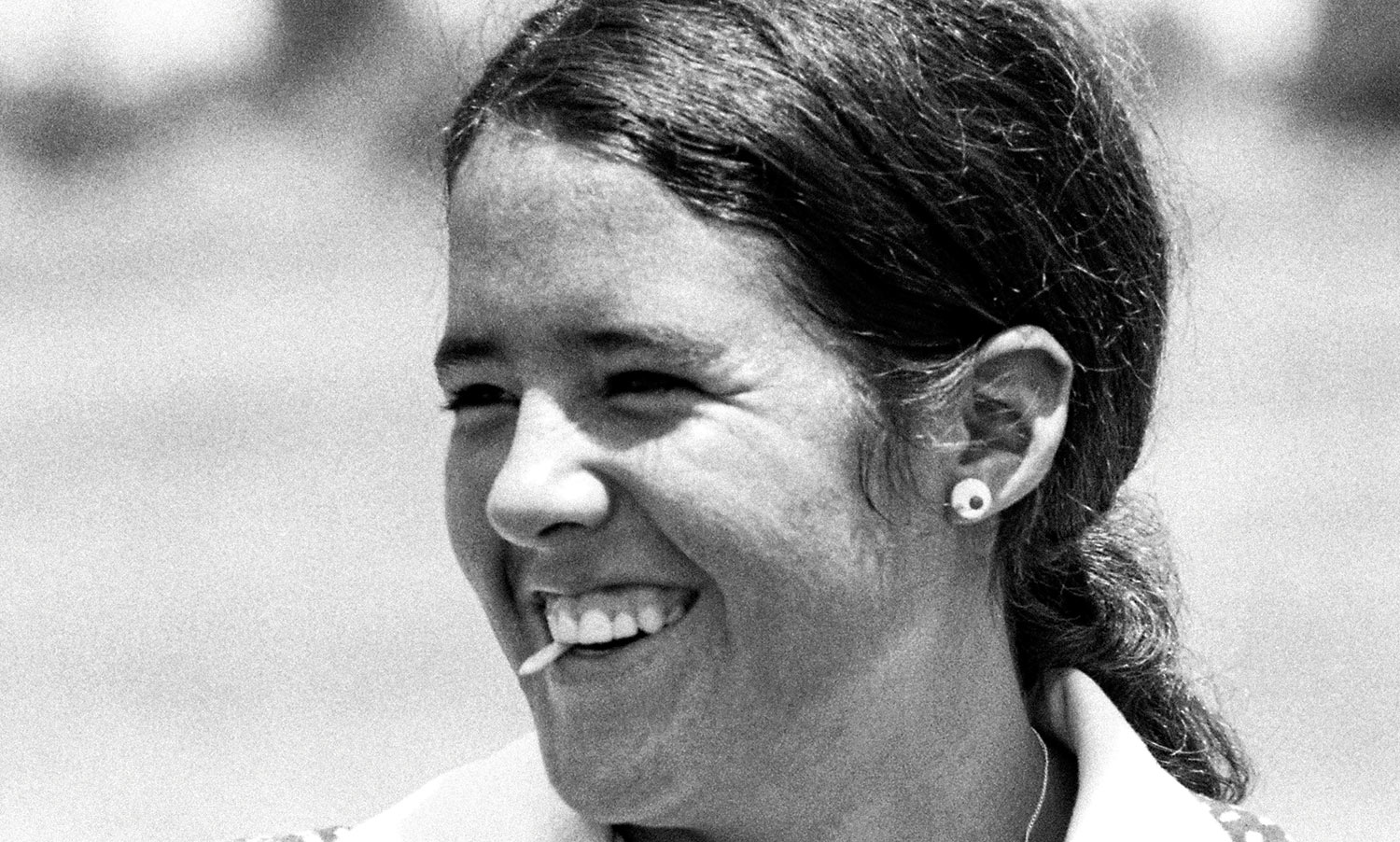
Sharp, driven and one of golf’s true naturals, Nancy Lopez considers the future of the LPGA, Latinas in the game, and how Mr. Blackwell got it wrong…
There never was any doubt about who was going to be the LPGA’s Rookie of the Year in 1978. Nancy Lopez, the 21-year-old phenom from Roswell, New Mexico, won nine tournaments in her debut pro year—the most wins in any rookie LPGA season, and perhaps in any rookie golf season. That year she also became the first in LPGA history to win five tournaments in a row, and the first to take Rookie of the Year, Player of the Year, and the Vare Trophy (lowest scoring average) in a single season. The Associated Press added a “Female Athlete of the Year” award for good measure—and then, just to prove it wasn’t a fluke, Lopez came back in her sophomore season and won eight of 19 tournaments, again taking the Vare Trophy and Player of the Year.
Looking back at her World Golf Hall of Fame career now, her 48 LPGA victories (including three majors), and all of the awards and accolades and achievements, she’s regarded as one of golf’s greats, a supreme athlete who changed the game.
But from the late 1970s through the late 1980s, when she was setting the golf world on fire, it wasn’t always her game that led the stories written about her. Lopez’ looks were as discussed in media, as was the fact that she was the first Latina on the LPGA Tour.
Today, in the era of #MeToo, “woke” multiculturalism and global media, Lopez sees that some things in the world have changed and some have not, but she knows for certain that the trail she helped to blaze still begins at the same place: a young girl with a dream who picks up a golf club and believes she can achieve anything. That, she says, is why she’s still in the game.
“Back in those days, when I was learning, there were issues with racism—I don’t like that word, I hate to use it, but being Hispanic some doors were closed in my dad’s face,” she says from her home in Florida. “Me, being a young person, didn’t really get it, and dad wasn’t the kind who said we were treated a certain way, and so I didn’t know there was prejudice going on. He always said ‘just work hard. Your word is all you have. Be good to people and you’ll go far in life.’ And I think that’s so important, no matter the color of our skin: show the best of you. My dad always taught me that. It was never ‘poor us’ or ‘poor me.’ I thought I could save the world because he was always positive, he encouraged me and told me I could do anything I wanted to.”

That positivity endured and carried Nancy, even if the Lopez family didn’t obviously fit into the golf landscape, not at first anyway.
“When I was young, 8, trying to learn, we’d be playing on a municipal golf course and I was always thinking that golf was a rich man’s sport, and we were not rich. We had to walk, we didn’t ride carts… When I would get my winter coat, it would be in the summertime. We’d put it on layaway. Those times were special, even though it was a struggle for my mom and dad. I looked forward to getting that coat when the winter came because it was beautiful and it was new.
“When I kept playing, and was playing as an amateur, my dad saved every year to give me an opportunity to play in the U.S. Junior or U.S. Open, all of these events. And you’d be around the pro world and you got to see people who had really nice golf bags, who looked like they were having a wonderful time, a wonderful life, and your parents want that for you—and it looks like fun, and you’d see these nice golf balls and gloves, my dad had to pay for all of that. I couldn’t even accept a free golf ball, there were a lot of rules and regulations. But it was fun to see those people and what they had, and I kind of wanted that a little bit. It wasn’t like I needed to have it, but I thought if I could be good at this, then maybe that’s the goal I needed to set.”
She not only set the goal, she met it, taking the 1969 New Mexico Women’s Amateur at the age of 12 and the U.S. Girls’ Junior in 1972 and 1974, at the ages of 15 and 17. As a freshman at the University of Tulsa in 1976 she won the AIAW National Intercollegiate Golf Championship and was a member of the U.S. Curtis Cup and World Amateur teams, ultimately being named All-American and Female Athlete of the Year. She left college and turned pro in 1977, and was runner-up in the U.S. Women’s Open for the second time (in her third appearance). And she kept breaking ground.
“My idol was [LPGA legend] JoAnne Carner,” Lopez says. “There wasn’t a Mexican idol for me to follow and so JoAnne Carner, she became my role model. And you want that person. Just like Se Ri Pak, she started that craziness with everyone coming from Korea, girls seeing her and thinking ‘I want that life,’ ‘I want to be a rock star.’ Lorena [Ochoa] did so much for all of the Mexicans with what she stood for in Mexico. Young girls see that.
“For young Latinas today, you’ve got to give them the opportunity. Get on a golf course, swing a club, open doors for them to get to college, get a scholarship—it opens a lot of doors for people who can’t afford all of that. Golf really did give me an opportunity—my dad did, really—and I hope that I’ve opened a door or two.”
More than two, certainly. Lorena Ochoa once told Kingdom that when she started in college in 2000 at University of Arizona, there were only two or three Latinas in the college game. Today there are many, and where Nancy Lopez was the first Latina in the LPGA, more and more are following each year. American women like Lizette Salas, Lee Lopez and Gerina Mendoza Piller (who, like Nancy Lopez, is from Roswell) are on the LPGA Tour, and women from Spain, Mexico and South and Central America also are represented. But if representation is getting better, what about how Latinas in the game are covered—or women in general? Lopez says it’s a tough question.

At the end of the 1970s, when Lopez was rewriting the record books on course, media outlets such as People magazine were noticing her—but not always focusing on her game. Media seemed obsessed with her weight, and even got into the numbers: “In recent weeks Lopez has dropped from 150 to 135 pounds (5’4”, she once weighed 170)” declared a June, 1978 People article/, before eventually mentioning her record-setting rookie year. “A chubby charmer,” “Cherubic and charming” and so on; articles discussed her legs, her sunbathing, offered to-the-pound coverage of her weight gains and losses, invented titillating tidbits and inflated details of her relationships, sometimes sprinkling in golf coverage. In today’s world, except for the tabloids, such coverage is almost unthinkable.
“Back then on the LPGA Tour we were not given credit for how we played, but for who were the best-looking women. For some reason, media were always looking for something a little negative to write about,” Lopez says. “Jan Stephenson was our sex symbol, and Laura Baugh; they brought people in. I think some were trying to make me a sex symbol, too. A big thing was femininity, how we looked, how we dressed.”
Lopez says she made the then-famous/infamous fashion “Blackwell’s List” as the 10th-worst dressed woman for 1980, and that she didn’t understand it at all; she dressed well—and wasn’t she winning?
“Winning nine tournaments in a rookie year, that brought a lot of attention to the tour, but then they’re talking about your weight and stuff. That causes issues with you as a person and how you feel about yourself. You realize that’s what people notice, and I think during that time I probably struggled with a lot of that. Golf was very important to me, and sometimes I sat there and thought, ‘Why are they thinking this way? Why aren’t they just looking at my golf game?’ They did that kind of stuff back then, always critiquing what we looked like. That’s the thing about fighting for equality for women: in anything they do, they’re evaluated differently.”
Today’s players are subjected to a lot of the same in media, although it does feel that they have more of a voice to push back—and access to more support as well. Lopez says current players also, for the most part, seem more aware of and in control of their appearance and their games.
“Players now, they wear short skirts, they’re in great shape. I think it’s great if they want to feel attractive, but for me it’s still golf first. I would not want them to feel like physical has to be first and golf second. I was always struggling with my weight, but thinking about my dad, he kind of didn’t like it when I got thin. He would say ‘10 more pounds, 10 more yards!’ If you got too thin you couldn’t hit the ball anymore. These girls are thin and strong. We didn’t have a workout trailer, I ran a little bit, but it was a whole different time. But I hope it doesn’t cause a mental thing today, I hope they’re happy, satisfied with playing great and winning and I hope they’re not discouraged because someone says ‘it looks like you’ve gained five pounds!’
“We’ve fought that forever. I’m not a women’s libber—I love my husband opening doors for me, love being treated like a lady—but there’s a fine line there and I want respect as a woman. Because I’m smart, because I play a sport a lot of men wish they could play well. The LPGA players work so hard and yet they make so much less than the men. I just don’t understand it; we are still knocking on that door every day… We’ve been fighting to get to the next tier, and the next tier, and we’re getting there, but so many times, when I was in those meetings as a rookie in 1978, 1979, then going to an LPGA meeting ten years ago and they’re still talking about the same things? It’s changed, but it hasn’t changed.”

One thing that has changed with the LPGA is its reach. Between 2006 and 2020, 14 different players from nine different countries held the top spot in the Rolex Rankings, which rates the top women players in the world. Five No.1s were from South Korea, two were from the United States, then there were Annika Sorenstam and Ochoa from Sweden and Mexico, respectively, and players from Taiwan, Japan, New Zealand, People’s Republic of China and Thailand. It’s a far cry from when a Hispanic girl from New Mexico made waves for her heritage. Still, Lopez says, while this is fantastic in some ways, it does cause challenges for the growth of the women’s game at home.
“The LPGA has become such a worldwide tour now, and I think it’s great. The only thing is, when the players are playing here we need Americans to win. I say that with total respect. When I went to South Korea to play in an event that Se Ri Pak asked me to play in, no matter what, the people there didn’t want me to win.”
People want to see their hometown heroes win, no question, but then, as Lopez points out, the LPGA players aren’t always finding financial support or growth opportunities here at home. It’s something with which she says the Tour has struggled.
“I remember being on a committee with [LPGA Commissioner] Mike Whan and Annika, and that was a tough thing for Mike. We had a lot of tournaments here, but not as many as we needed, and he was wondering, ‘Should I take these players all over the world?’ That was a big issue for him, he wanted to figure out what was best. And what we decided and told him was, ‘If they can make money somewhere else, you need to take them there, Mike.’ And he did that, he found them places to play and places to make a living, to make money, and I think it’s fabulous.
“A lot of American players in my day didn’t want to travel… It was, ‘I just want to stay in America, I don’t want to have to go through the jetlag and all the other stuff.’ I think they’re getting acclimated to that now, and I think it’s great that we do have tournaments abroad and that companies from around the world are sponsoring tournaments here; I think that’s positive, for sure. I want our players to have a job, I want them to make a lot of money.”
She also wants them to enjoy life, she says, and, as her friend Arnold Palmer said, she wants them to “swing [their] swing.”
“As I was coming up, I was labeled as having an unorthodox swing,” she says. “I teach now, and I work with two other teachers, and we teach women to just hit it. Just swing it, make contact, get the hit. That’s pretty much my lesson. When you have natural ability, you just need the basic mechanics, and that’s it.
“Lee Trevino came to town when I was a little girl. People had been saying how bad my swing was, saying I wouldn’t get very far. My dad was concerned and so he took me to where Trevino was and asked, ‘Can you please watch my daughter swing a club?’ When I did it, Lee told my dad, ‘If it works, don’t change it. If it stops working, then change it.’ I had enough common sense and I remembered that, and if someone said something about my swing I pretended to listen and then I didn’t do it anyway… Today, everything’s the same swing, mechanical. When a natural talent comes along, let her play her game until it stops working.”
It’s an ethos Lopez carries through her various enterprises, which include the aforementioned instruction, a line of women’s golf clubs, and women’s clothing as well.
“There was not much attention paid to women when Nancy Lopez Golf started. They’d cut down shafts and put heads on them. We make golf clubs for women, and the clubs are great; I’ve swung them, I hit them. The clothing line has been great, too, and especially for women that are bigger. You go into a department store and try to find something golfy in a bigger size, it’s tough. I want women to feel good on the golf course. I want to give women success and contribute in that way if I can, to make them feel professional even if they’re amateurs. Nancy Lopez Golf has given me that opportunity to do that for women. And Nancy Lopez Golf Adventures, with Sue Powers and Teresa Zamboni, they’re great teachers. We want to teach people to golf, teach them to swing the way they can swing. And we travel, we take people all over the world. It’s fun for me. I’m not just there for lunch or just for dinner; I love to watch somebody hit a great golf shot and feel the satisfaction that I do in playing this great game. Giving back to golf is what I knew that I wanted to do when my career was over, and to be able to still participate and do what I can to help other people enjoy golf is what I’m going to do until I can’t do it anymore.”
Follow Us On


| Cookie | Duration | Description |
|---|---|---|
| cookielawinfo-checkbox-analytics | 11 months | This cookie is set by GDPR Cookie Consent plugin. The cookie is used to store the user consent for the cookies in the category "Analytics". |
| cookielawinfo-checkbox-functional | 11 months | The cookie is set by GDPR cookie consent to record the user consent for the cookies in the category "Functional". |
| cookielawinfo-checkbox-necessary | 11 months | This cookie is set by GDPR Cookie Consent plugin. The cookies is used to store the user consent for the cookies in the category "Necessary". |
| cookielawinfo-checkbox-others | 11 months | This cookie is set by GDPR Cookie Consent plugin. The cookie is used to store the user consent for the cookies in the category "Other. |
| cookielawinfo-checkbox-performance | 11 months | This cookie is set by GDPR Cookie Consent plugin. The cookie is used to store the user consent for the cookies in the category "Performance". |
| viewed_cookie_policy | 11 months | The cookie is set by the GDPR Cookie Consent plugin and is used to store whether or not user has consented to the use of cookies. It does not store any personal data. |